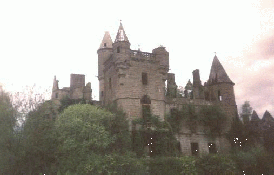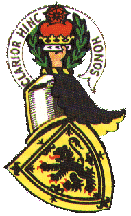


The Buchanans supported the cause of Bruce during the War of Independence and the fortunes of the family were thus assured. Sir Alexander Buchanan travelled with other Scottish nobles to fight for the French against Henry V of England, and fought at the Battle of Beauge in Normandy in March 1421. Buchanan's exploits during this battle are given as one explanation for the heraldry of the family: it is said that Sir Alexander killed the Duke of Clarence and bore off his coronet as a trophy, hence the ducal cap held aloft in the crest. The shield, which is virtually the Royal Arms of Scotland, differenced only by changing the lion and the double tressure of fleurs de lis from red to black. This is said to allude to the marriage of Sir Walter Buchanan to the only daughter of Murdoch, Duke of Albany and Regent of Scotland. The regent was ultimately beheaded by his cousin, James I, in 1425, when his estates were confiscated. Albany's son had died childless and the Buchanans were the nearest relatives to this disinherited branch of the royal family. The arms are said to mourn the family's loss of status.
 Also descended from the chiefly family were the Buchanans of Arnprior who held lands in Perthshire around Kippen. The Lairds of Arnprior lived in some style and were nicknamed the 'kings of Kippen'. Walter Scott relates a tale said to explain this title. James V was fond of travelling in disguise, using a name known only to his close friends and attendants. The king arrived at Arnprior to be met by a grim retainer who advised him that the laird was at dinner and could not be disturbed. The king retorted by asking him to tell the king of Kippen that 'the Goodman of Ballengeich is come to feast'. When Buchanan heard these words, he knew at once that it could only be the king at his door and begged his royal forgiveness. The laird was killed at the Battle of Pinkie in 1547. The ancient lands of Buchanan were to have been passed at the death of the last chief in 1682 to Buchanan of Arnprior, but instead were sold to meet heavy debts. The mansion house of Buchanan is now in the possession of the Graham Dukes of Montrose.
Also descended from the chiefly family were the Buchanans of Arnprior who held lands in Perthshire around Kippen. The Lairds of Arnprior lived in some style and were nicknamed the 'kings of Kippen'. Walter Scott relates a tale said to explain this title. James V was fond of travelling in disguise, using a name known only to his close friends and attendants. The king arrived at Arnprior to be met by a grim retainer who advised him that the laird was at dinner and could not be disturbed. The king retorted by asking him to tell the king of Kippen that 'the Goodman of Ballengeich is come to feast'. When Buchanan heard these words, he knew at once that it could only be the king at his door and begged his royal forgiveness. The laird was killed at the Battle of Pinkie in 1547. The ancient lands of Buchanan were to have been passed at the death of the last chief in 1682 to Buchanan of Arnprior, but instead were sold to meet heavy debts. The mansion house of Buchanan is now in the possession of the Graham Dukes of Montrose.
Perhaps the most famous Buchanan was the distinguished poet and protestant reformer George, who was born at Killearn in Stirlingshire in 1506, the third son of Buchanan of Drumikill. He moved to Paris around 1520 to continue his education and travelled extensively on the Continent, embarking upon a literary career. He returned to Scotland around 1560 and in April 1562 he was appointed tutor in classics to the young Mary, Queen of Scots. He received a measure of royal favour but this did not prevent his launching vicious attacks upon the queen in his writings. He was appointed preceptor and tutor to the young James VI after the abdication of his mother, and he is generally credited with laying the foundations for that monarch's considerable academic prowess as well, unfortunately, as poisoning the child's mind against his mother. James Buchanan was the fifteenth president of the United States of America. There has not been a recognised chief since the seventeenth century.
 The Gathering of the Clans
The Gathering of the ClansMy many thanks to George Butters, Webmaster of The Gathering of the Clans, for allowing me to use some of the outstanding information from his site for this page.

It is said that the Buchanans have the oldest established clan society in Scotland. The clan's heartland lies on a small island, measuring a mere half a mile in length, of Clar Innis or Clarinch on Loch Lomond. The Buchanans have ecclesiastical origins, and are hereditary clerics of the Celtic church. Some even say that the Buchanans are descended from the son of a King of Ulster, Anselan o'Kyan, who landed in Argyll at the beginning of the 11th century.
The Buchanan lands, lying to the east of Loch Lomond, remained in the family for almost seven centuries. But after the John, the 22nd laird died they were sold in 1682 to the Marquess of Montrose. Despite the fact that there were many cadet branches - Leny, Carbeth, Drumakill, Arnprior, Spittal and Auchmar - the clan thereafter became dispersed.
The Buchanan clan presently has no chief.
The name Buchanan is of territorial origin from lands in Stirlingshire bordering Loch Lomond, originally known by the Gaelic name
"Buth
The first record of the name appears in 1224 when Dominus Absolone de Buchkan witnessed a charter by Malcolm, Earl of Lennox. King David II officially recognised the family of Buchquhanane in the 14th century and the clan prospered with a number of cadet branches; Arnprior, Auchamar, Carbeth, Drumakill, Leny and Spittal. In the early period of the clan system they were active in various wars, supporting Robert the Bruce and later fighting at Flodden and Pinkie. There were a number of Buchanans amongst the seven thousand sent from Scotland who fought for the King of France at Agincourt.
Towards the end of the 17th century the house and lands of Buchanan were sold to the Marquess of Montrose, Chief of Clan Graham, after the death of John Buchanan of that Ilk. His death meant the mainline of the chiefship passed to the Auchamar branch, and upon its failing it passed to the Spittal family. The Buchanans of Leny were the last to hold the chiefship which is now dormant. The clan has since scattered worldwide over the centuries. However, Clairinch, an island in Loch Lomond from where the clan took its war cry was purchased by a wealthy clansman who presented it to the Clan Society and the island is now a nature reserve.
 Electric Scotland
Electric ScotlandI owe a debt of gratitude to Alistair McIntrye, WebMaster of Electric Scotland, for his generosity in allowing me to use some of the marvelous information from his site for this page.

 The Clan Buchanan Society International Inc.
The Clan Buchanan Society International Inc.
 Buchanan Lineage
Buchanan Lineage
 Quin McWhirter's HomepageThe fine homepage of Quin McWhirter, of the Clan Buchanan. This is a must see site.
Quin McWhirter's HomepageThe fine homepage of Quin McWhirter, of the Clan Buchanan. This is a must see site.
 Clan Buchanan
Clan Buchanan
